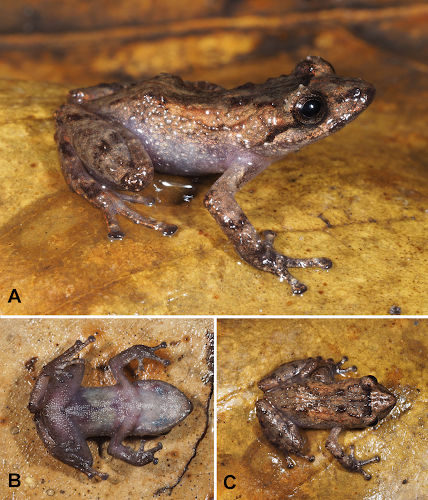 |
| Pristimantis samaniegoi & Pristimantis matildae Székely, Eguiguren, Ordóñez-Delgado, Armijos-Ojeda & Székely, 2020 |
Abstract
Abra de Zamora is an important biodiversity hotspot in southern Ecuador. Between 1938 and 2010, eleven species of frogs were described from here: Lynchius flavomaculatus, Gastrotheca psychrophila, Pristimantis balionotus, P. colodactylus, P. cryptomelas, P. percultus, P. versicolor, P. vidua, Telmatobius cirrhacelis, P. andinognomus, and Atelopus podocarpus. Unfortunately, many of these species were not re-encountered after their original description, and for the majority DNA samples were not available, making their phylogenetic position unknown. In this study, we assess the current state of the amphibians from Abra de Zamora, by: i. redescribing the species which were first reported from the area, by contributing genetic delimitation (for L. flavomaculatus, P. balionotus, P. colodactylus, P. percultus, and P. vidua), release call (L. flavomaculatus) and advertisement call descriptions (for P. balionotus, P. vidua and P. versicolor); ii. presenting an updated amphibian species list of Abra de Zamora, with the description of two additional Pristimantis species; iii. updating the distribution of these species, including data collected in similar montane habitats from surrounding areas; and iv. amending recommendations regarding their conservation status.
 |
| Fig 10. Holotype of Pristimantis samaniegoi sp. nov. (MUTPL 357, adult female), SVL 20.1 mm, in life. A. Lateral view; B. Ventral view; C. Dorsal view. |
Pristimantis samaniegoi sp. nov. Székely, Eguiguren, Ordóñez-Delgado, Armijos-Ojeda, and Székely
Etymology. The specific epithet is a noun in the genitive case and is a patronym for Dr. Gustavo Samaniego Rodríguez. The name is given as a tribute to his important contribution to the conservation of biodiversity in southern Ecuador. Through a generous donation of an important part of his estate, he contributed to the creation of the administrative and interpretation center in the Cajanuma sector of the Parque Nacional Podocarpus, which is one of the most important Ecuadorian sites of endemism and biodiversity. He was a university professor for over 40 years, and currently still maintains the "Reserva El Cristal" agro-ecological farm as an example of sustainable land management.
Distribution. Pristimantis samaniegoi is known only from the Cajanuma entrance to the Parque Nacional Podocarpus and about 13 km in the north, in Abra de Zamora (Fig 6). We did not encounter this species in any similar habitats located in the vicinity of the type locality, despite fieldwork being carried out regularly since 2016. The species was encountered at an altitudinal range between 2560 and 3300 m a.s.l., in evergreen upper montane forest (Fig 2C), subpáramo (Fig 2B) and shrub páramo ecosystems.
 |
| Fig 16. Holotype of Pristimantis matildae sp. nov. (MUTPL 731, adult male), SVL 20.2 mm, in life. A. Lateral view; B. Ventral view; C. Dorsal view. |
Etymology. The specific epithet is a noun in the genitive case and is a patronym for Matilde Hidalgo Navarro (1889–1974). She was the first woman to obtain a medical degree in the country, and the first woman in Ecuador (and Latin America) to exercise the right to vote in a national election. A tireless fighter for women’s rights, she laid important foundations for the development of women in academia and science, nationally and in South America. In Ecuador, there are currently many women involved in biological sciences and with this species, in addition to being a tribute to Matilde, we honor their tireless work for the conservation of biological diversity.
Distribution. Pristimantis matildae is known only from Abra de Zamora and the Cajanuma sector from the Parque Nacional Podocarpus, about 13 km to the south (Fig 6). We were not able to encounter this species in adjacent areas, with similar ecosystems. However, about 35 km south from the type locality, we found another bromeliad specialist from the P. colodactylus subgroup, a genetically and morphologically similar, undescribed species. Pristimantis matildae was encountered at an altitudinal range between 2800 and 3360 m a.s.l. in subpáramo (Fig 2B) and shrub páramo ecosystems.
Natural history. This is a common species and one of the most abundant species encountered inside of bromeliads. All the specimens were encountered in terrestrial or arboreal bromeliads or in their close proximity (perching on the leaves), during the day or night. Similarly to P. colodactylus and P. muranunka, this species displayed the same defensive behavior of rapidly retreating to the water from the bromeliads when threatened. No calling males were heard.



